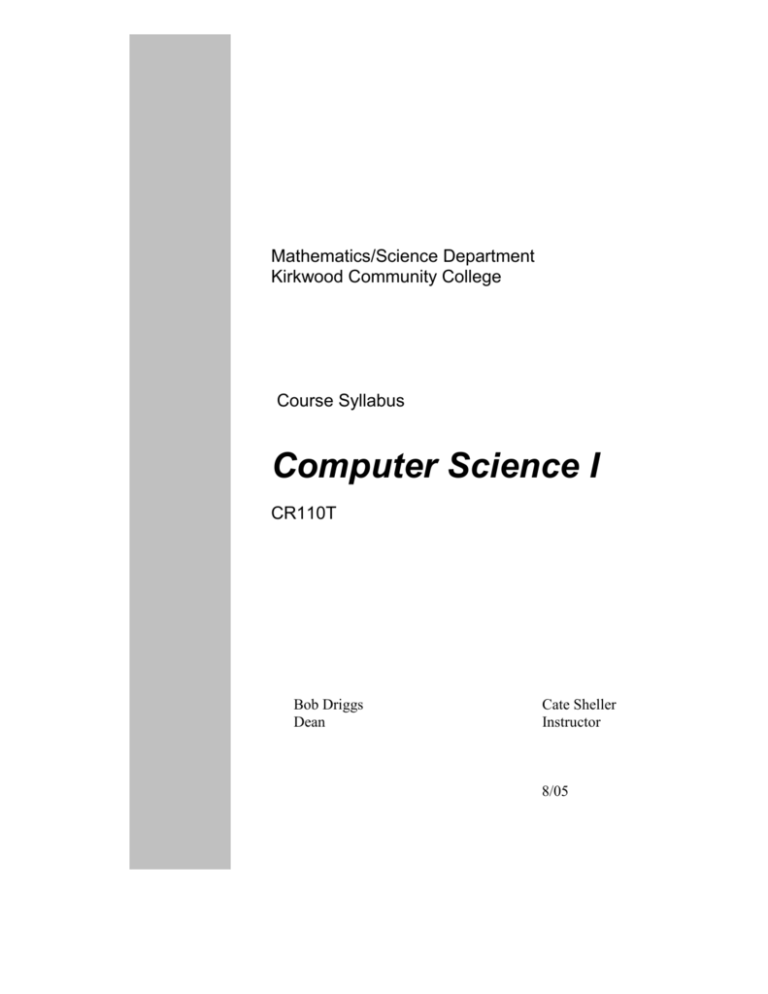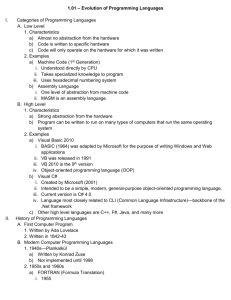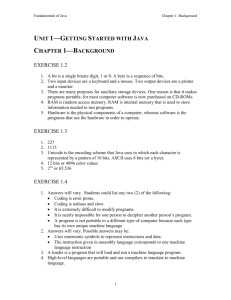
Mathematics/Science Department
Kirkwood Community College
Course Syllabus
Computer Science I
CR110T
Bob Driggs
Dean
Cate Sheller
Instructor
8/05
Computer Science I (CR110T)
Course Description
Introduces computer programming , including data types, expressions, input/output, control
structures, functional and object-oriented programming, and simple data structures. The course
emphasizes problem solving skills through program refinement, documentation and
programming style. Prerequisite: MT106U (Intermediate Algebra for Pre-Calculus) Credit
Hours: 4
Resources
Books:
Savitch, Walt. Absolute Java, 2006, Pearson/Addison-Wesley (required text)
Wu, C. Thomas. An Introduction to Object-Oriented Programming with Java, 4th
edition, 2006, McGraw-Hill
Web sites:
Kumar, Amruth. Web-based tutors for C++/Java Programming,
http://acharya.ramapo.edu/~amruth/tutors/m06/kcc/home.html
Java 2 Platform Standard Edition 5.0 API Specification,
http://java.sun.com/j2se/1.5.0/docs/api
The Java Tutorial, http://java.sun.com/docs/books/tutorial/index.html
Software:
Java 2 Platform Standard Edition (J2SE 5.0)
Text editor and/or IDE (e.g. BlueJ)
Hardware: personal computers
General Course Objectives
Students will learn basic concepts of computer science and programming
Students will write programs using Java
Students will read, interpret, trace, extend, and debug program code
Students will document programs thoroughly and succinctly
Students will be able to explain and apply object-oriented programming techniques
Detailed Objectives
Unit I: Basics
At the conclusion of this unit, students will be able to:
Name and describe the major hardware components of computers
Describe how data and instructions are stored in a computer
Define the following terms:
o Program
o Programming language
o High-level language
o Low-level language
o Syntax
o Semantics
Explain the following concepts in an object-oriented programming context:
o Objects and classes
o Methods and messages
o Inheritance, superclasses and subclasses
Differentiate between class and instance methods and data values
Describe the software development cycle
Identify the basic components of a Java program
Describe the process of writing and running Java programs
Define the following terms:
o Compiler
o Interpreter
o Java Virtual Machine
o Source code
Write Java programs containing a single class and a single method
Instantiate objects and call methods from standard Java packages
Design and develop programs that solve simple problems using an incremental approach
Write appropriate internal documentation
o Declare meaningful identifiers
o Write informative comments
o Use consistent style with regard to program layout – indentation, use of spacing,
etc.
o Use javadoc to generate external documentation
Explain the concept of data type
Declare variables and manipulate values using Java’s primitive data types
Write and evaluate arithmetic expressions in Java using literal values, primitive-type
variables, and Math class methods
Compare and contrast memory allocation mechanisms for objects and primitive types
Use standard Java classes to perform programming tasks:
o Input and output
o Format numeric data
o Data type conversion
o Generate random numbers
Unit 2: Classes, methods, and control structures
At the conclusion of this unit, students will be able to:
Define classes containing multiple methods
Explain the difference between public and private methods and data members, and use
each appropriately in programs
Define and use void and value-returning methods
Differentiate between local and instance variables, and use each appropriately in
programs
Trace execution of programs using multiple methods
Pass primitive and object parameters to methods
Write class constructors
Define the following terms:
o Overloading
o Default constructor
o Encapsulation
o Mutator
o Accessor
Read and write Java code containing selection control structures
Implement selection control in Java programs using if, if/else, nested if/else and switch
statements
Read and write logical and relational expressions
Recognize equivalent logical and relational expressions
Evaluate Boolean expressions correctly
Describe how objects are compared
Choose appropriate selection control structures for given tasks
Use selection control structures to solve programming problems involving comparison
and decision-making
Read and write Java code containing loops
Implement loop control in Java programs using while, do/while and for statements
Read and write methods containing nested loop control structures
Choose the appropriate loop control structure for a given task
Recognize, explain, correct and prevent looping errors, including off-by-one errors and
infinite loops
Write simple recursive methods
Use loop structures to solve programming problems involving repetition
Define the following terms:
o Count control
o Sentinel control
o Priming read
o Pretest loop
o Posttest loop
Read and write programs using combinations of selection and looping structures,
including nested structures
Trace execution of code containing looping and selection structures
Test and debug programs using selection and iteration structures
o Select appropriate test data
o Fully exercise code
Write methods that return objects
Describe the uses of the keyword this
Differentiate between reference parameters and value parameters
Define class methods and variables
Organize classes into packages
Unit 3: Data structures and advanced topics
At the conclusion of this unit, students will be able to:
Declare and manipulate data of the char type
Write programs that process strings
Specify string search patterns in the form of regular expressions
Use the String, StringBuffer and StringBuilder classes appropriately in programs
Explain the difference between equality and equivalence testing as applied to String
objects
Define the following terms:
o ASCII
o Unicode
o Index
o Substring
o Regular expression
Manipulate collections of data values using arrays of primitive data types or objects
Define a method that accepts an array parameter
Define a method that returns an array
Write programs that store and manipulate data using two-dimensional arrays
Describe two-dimensional array implementation in terms of an array of one-dimensional
arrays
Improve code reliability by incorporating exception-handling mechanisms
Implement try-catch blocks
Implement multiple catch blocks
Define the following terms
o Exception
o Checked exception
o Unchecked exception
Write methods that throw exceptions
Write programs that read and write files
Use FileInputStream and FileOutputStream to perform low-level file i/o
Use DataInputStream, DataOutputStream, ObjectInputStream and ObjectOutputStream to
perform high-level file i/o on primitive data types and objects
Read text files using a Scanner or a BufferedReader
Write a text file using PrintWriter
Create a simple GUI application using Java Swing objects
Write event-driven programs
I. Instructional Methods
Lecture/Discussion: Class meets four times per week for one hour at a time; the
primary method of presentation during these sessions is lecture/discussion.
Structured Labs: During regular class time, students are given problems to work
out using computers and programming tools; structured labs occur approximately
every week throughout the semester
In-Class Exercises: Students are given opportunities throughout the semester to
practice problem-solving skills through brief individual and group exercises
designed for immediate practice of concepts demonstrated in lecture
Homework: Students gain proficiency with the programming language and
mastery of the concepts taught in class through a series of homework assignments
in which they write original programs given problem specifications
Evaluation
Exams and Quizzes 60%
Homework Problems and Programs 40%







